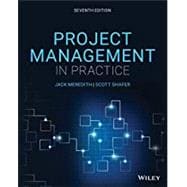Project Management in Practice, 7th Edition presents an applied approach to the essential tools, strategies, and techniques students must understand to achieve success in their future careers. Emphasizing the technical aspects of the project management life cycle, this popular textbook offers streamlined, student-friendly coverage of project activity, risk planning, budgeting and scheduling, resource allocation, project monitoring, evaluating and closing the project, and more.
Providing new and updated content throughout, the seventh edition’s concise pedagogy and hands-on focus is ideally suited for use in one-semester courses or modules on project management. Clear and precise chapters describe fundamental project management concepts while addressing the skills real-world project managers must possess to meet the strategic goals of their organizations. Integrated throughout the text are comprehensive cases that build upon the material from previous chapters—complemented by wealth of illustrative examples, tables and figures, review questions, and discussion topics designed to reinforce key information.









